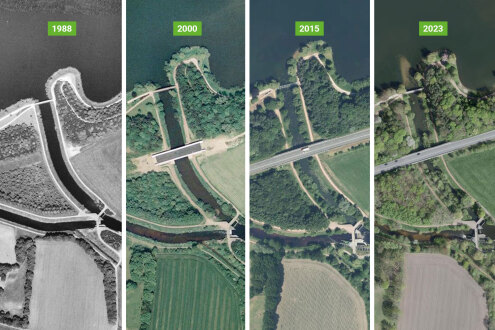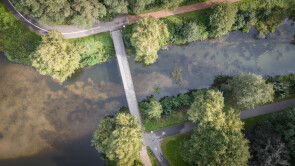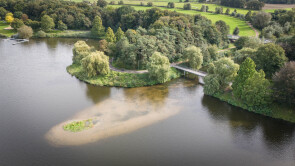Flood protection: desanding of the Aasee inlet from next week
In November, the city of Bocholt begins desanding the inlet to Bocholter Aasee to ensure that the lake can continue to fulfil its important flood protection role in the future. This measure will ensure the flow of water.

© Kreis Borken / Datenlizenz Deutschland - Zero-Version 2.0
The aerial photos show how the inlet has silted up over the last 30 years
Over the years, large quantities of sand and sediment have been deposited in the inlet area of the Aasee. The vegetation has also changed considerably: Open water areas have been replaced by sandbanks and dense plant carpets. This development restricts the ability of Lake Aa to act as a buffer for excess water during floods.
Desanding removes these deposits and ensures the flow of water in the event of flooding. The removed sand is first stored temporarily on a specially prepared area in the area of the bathing bay, dewatered and then transported away. The material can be reused in road construction or to fill other construction sites, for example.
The work is scheduled to last until May 2025 so that the bathing bay can be fully utilised again before the start of the next bathing season. It is estimated that around 27,000 tonnes of sand will be removed. In order to make the work as pleasant as possible for local residents, construction traffic will be diverted to the B67 via the P+R car park, and a security guard will be deployed on Erich-Kästner-Straße.
Effects on water quality
Although the city of Bocholt also expects the reduction of vegetation in the inlet area to improve water quality, it emphasises that this is primarily a flood protection measure. The inlet to the Aasee is only "activated" during floods, so that water from the Bocholter Aa can reach the Aasee. Under normal conditions, there is no connection and the lake remains cut off from the inlet by a weir.
Commuter car park closed
The commuter car park between Ostring and Hohenhorster Straße will be closed from next week for the duration of the desanding work, according to the city of Bocholt. The area is required for the removal of the sand.





